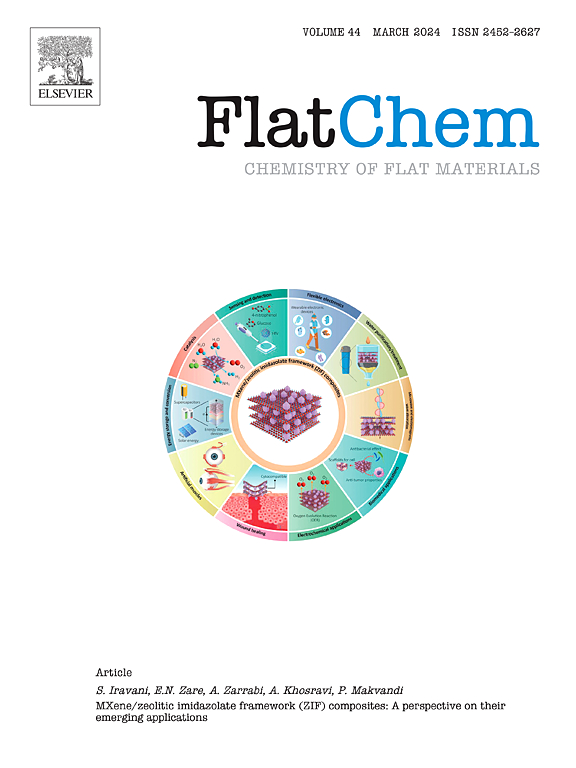Graphene oxide functionalized halloysite nanotubes for voltammetric determination of psychoactive drug from alcoholic and non-alcoholic drinks
IF 5.9
3区 材料科学
Q2 CHEMISTRY, PHYSICAL
引用次数: 0
Abstract
In context to the widespread misuse of benzodiazepines, a novel platform based on the graphene oxide functionalized halloysite nanotubes (HNT/GO) has been introduced for the electrochemical detection of commonly abused date rape drug-nitrazepam (NZP). In this work, HNT/GO composite has been synthesized via simple stirring method and the fabricated materials were characterized by using combination of spectroscopic, microscopic, X-ray and voltammetric techniques i.e., FTIR, FE-SEM-EDX, TEM, XRD, XPS and Cyclic voltammetry. Surface modification of HNTs with GO increased the synergistic properties of both the materials for electrochemical sensing of nitrazepam. Specifically, HNTs provided high surface area, nanotubular morphology with unique surface functionalities and GO added electron rich functional sites. Combination of HNTs with GO significantly increased electrochemical active surface area from 0.06 to 0.236 cm2 which increased electron transfer on the surface of electrode towards electrochemical reduction of nitrazepam. The developed sensor showed excellent electrochemical response for nitrazepam detection with a linear dynamic range of 0.16–150 μM and limit of detection 0.79 μM. The proposed sensor has successfully been employed for electrochemical determination of nitrazepam in non-alcoholic and alcoholic drinks without any sample pre-treatment.

氧化石墨烯功能化哈洛石纳米管用于伏安法测定酒精和非酒精饮料中的精神活性药物
在苯二氮卓类药物滥用的背景下,一种基于氧化石墨烯功能化高岭土纳米管(HNT/GO)的新型平台被引入到常用的约会油菜药物硝西泮(NZP)的电化学检测中。本研究采用简单搅拌法合成了HNT/GO复合材料,并利用FTIR、FE-SEM-EDX、TEM、XRD、XPS和循环伏安法等光谱、微观、x射线和伏安技术对制备的材料进行了表征。用氧化石墨烯对HNTs进行表面改性,提高了两种材料对硝西泮电化学传感的协同性能。具体来说,纳米碳管提供了高表面积,具有独特表面功能的纳米管形态,氧化石墨烯增加了富含电子的功能位点。HNTs与氧化石墨烯的结合使电化学活性表面积从0.06增加到0.236 cm2,增加了电极表面对硝西泮电化学还原的电子传递。该传感器对硝西泮的电化学响应良好,线性动态范围为0.16 ~ 150 μM,检出限为0.79 μM。该传感器已成功地用于不含酒精饮料和含酒精饮料中硝西泮的电化学测定。
本文章由计算机程序翻译,如有差异,请以英文原文为准。
求助全文
约1分钟内获得全文
求助全文
来源期刊

FlatChem
Multiple-
CiteScore
8.40
自引率
6.50%
发文量
104
审稿时长
26 days
期刊介绍:
FlatChem - Chemistry of Flat Materials, a new voice in the community, publishes original and significant, cutting-edge research related to the chemistry of graphene and related 2D & layered materials. The overall aim of the journal is to combine the chemistry and applications of these materials, where the submission of communications, full papers, and concepts should contain chemistry in a materials context, which can be both experimental and/or theoretical. In addition to original research articles, FlatChem also offers reviews, minireviews, highlights and perspectives on the future of this research area with the scientific leaders in fields related to Flat Materials. Topics of interest include, but are not limited to, the following: -Design, synthesis, applications and investigation of graphene, graphene related materials and other 2D & layered materials (for example Silicene, Germanene, Phosphorene, MXenes, Boron nitride, Transition metal dichalcogenides) -Characterization of these materials using all forms of spectroscopy and microscopy techniques -Chemical modification or functionalization and dispersion of these materials, as well as interactions with other materials -Exploring the surface chemistry of these materials for applications in: Sensors or detectors in electrochemical/Lab on a Chip devices, Composite materials, Membranes, Environment technology, Catalysis for energy storage and conversion (for example fuel cells, supercapacitors, batteries, hydrogen storage), Biomedical technology (drug delivery, biosensing, bioimaging)
 求助内容:
求助内容: 应助结果提醒方式:
应助结果提醒方式:


